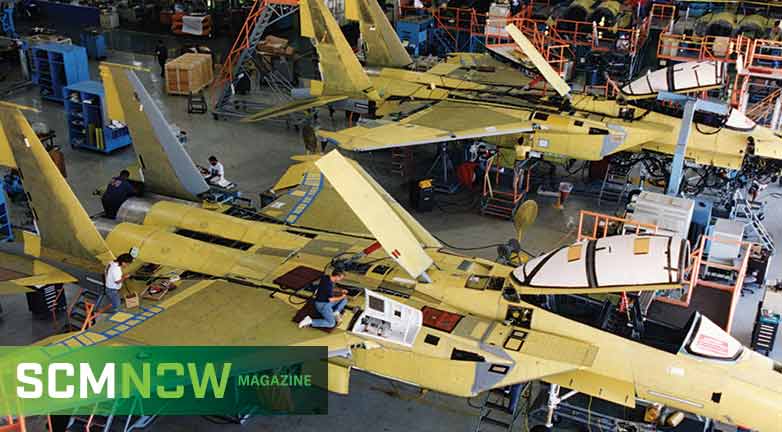Editor’s note: Boeing Co. was the winner of the 2020 ASCM Award of Excellence — Learning and Development. This award recognizes an organization’s commitment to productivity and advancement based on the effective and ongoing application of educational concepts, competencies and best practices from ASCM performance-driven team training and the APICS body of knowledge.
Chicago-based Boeing Co. is a leading manufacturer of commercial jetliners and defense aircraft for customers in 150 countries around the world. As with any large business, Boeing has a high level of complexity that can present challenges in managing its global supply chain network, says William Ampofo, vice president of supply chain for Boeing Global Services (BGS).
The company is organized into three primary business units: Boeing Commercial Aircraft (BCA), which manages the production of commercial parts; Boeing Defense, Space and Security (BDS), which handles the company’s defense portfolio; and BGS, which contributes aftermarket parts and services for both commercial and defense products. In total, these groups are composed of approximately 140,000 employees working in 413 locations around the world. The groups also manage more than 12,000 suppliers globally. Each business unit has its own product-related enterprise operations programs — in total, about 180 main programs that are then subdivided further by specific customer or contract requirements.
The way these programs used to be managed varied by business unit. In some cases, the differences were a result of mergers and acquisitions. “This often has been to Boeing’s advantage,” Ampofo says. “Our teams have taken aspects done well in one location and adopted them to improve other locations. However, this scenario resulted in a mix of differing command media, business rules, practices and systems.”
Furthermore, the different business units had varying levels of supply chain maturity and capabilities, which sometimes were not fully integrated or leveraged. Unique support and services supply chain solutions were developed individually, which ultimately isolated the adoption of best practices.
Leaders knew there had to be a better way: “With growing competition and a constantly changing business environment, as seen by the recent COVID-19 pandemic, Boeing recognized it as key to incorporate industry standard frameworks and tools to reduce non-value-added activities, reduce complexity, align the enterprise with a common language, and ultimately improve the way it operates,” Ampofo says.
To achieve these goals, Boeing leaders cultivated an enterprise group to transform, improve and integrate the company into standardized sets of operating models under the One Boeing initiative. This group identified a list of goals:
- Provide a common supply chain language across the enterprise.
- Develop a portfolio of improvement projects to address pain points.
- Create a smaller number of differentiated standard operating models that can be deployed around the business for each customer segment to enable standardization in operations, which in turn supports operational excellence.
- Introduce standard performance metrics to enable a common understanding of performance gaps and root-cause and corrective action activities.
- Reduce onboarding time and increase productivity and transferability of employees.
- Clearly define responsibility, accountability and authority based on capability rather than organizational design.
- Create a learning pathway for employees that ensures the organization can attract and retain the best talent and empower teams to make the changes that are needed.
SCOR educational program fuels supply chain learning
The first goal was key to achieving the others. Because practices across the business units around the world were so diverse, it was critical that all employees first speak the same supply chain language to foster effective practice integration and implementation, Ampofo explains. Boeing leaders identified the APICS Supply Chain Operations Reference (SCOR) model as the best tool for this because the framework provides a common language for processes, performance, people and practices across the entire supply chain network.
In partnership with ASCM, Boeing leaders created an enterprise-wide training program to educate supply chain and operations teams about the SCOR model. This started with 10 internal SCOR-Professional (SCOR-P) courses. To date, 240 employees have earned the SCOR-P endorsement. And with the support of ASCM, some of these endorsees delivered in-depth leader-level training to more than 600 executives, senior managers and their employees.
Taking this a step further, an ASCM SCOR Master Coach hosted a one-day Train the Trainer course for the SCOR-P endorsees to give them the confidence to provide further SCOR overview training around the enterprise without the help of an ASCM SCOR Master Coach. These new trainers then were required to train at least 20 additional team members at their locations, educating 200 more Boeing team members about SCOR and helping the organization reach its common language goal.
“Having an APICS education has helped me use industry standards to speak the same process language and discuss guiding metrics across different organizations,” says Kiku Yasukawa, manager of supply chain plan - supply and inventory. “This has helped us find systemic problems and easily partner to share best practices in order to combat the universal issues.”
Diny Konstantina Kokkinou, planner and supply chain specialist, says the training has made her a more effective contributor. “APICS education, to me, means broadening the way I think about the business but also the tasks that need to be carried out,” she explains. “Through my SCOR-P and [APICS Certified in Production and Inventory Management] certifications, I have a better understanding of the end-to-end processes and therefore can find the root cause of a problem faster and think of long-term solutions that could be applied on a wider scale.”
SCOR transformation improves Boeing fighter plane program
Many of the trained individuals also began applying their knowledge through SCOR Transformation Learning Programs (TLPs). To date, Boeing has completed four TLPs across BCA, BDS and BGS about production and sustainment programs.
“Using the SCOR framework and their training, the teams were able to collaborate with the program teams to improve specific supply chain pain points and identify common theme areas across functions and programs to be worked on at an enterprise level,” Ampofo says.
One of the TLPs worked to resolve supply, quality and production scheduling challenges within the company’s fighter plane programs in St. Louis. Phil Ament, who was the Boeing Defense, Space and Security vice president of Strike, Surveillance and Mobility at the time of the TLP, recounts that in January 2019, the Boeing SCOR team reached out to help solve these challenges while Ament’s team handled the daily firefighting. “It was the beginning of an engagement that changed our focus and shifted our minds to systemic corrective action,” he says. “I’m a believer.”
Within 90 days, the SCOR team was able to clearly define the fighter program’s deficiencies, map them to best practices and make recommendations for improvement. In June, when the program’s production lines were headed into factory resets, the SCOR team began implementing the needed changes.
Ament says there were two key changes in particular that made a significant difference: The first is master schedule adherence and alignment to material requirements planning and inventory policy. The program management team rewrote the business process improvement plan to incorporate a disciplined, multifunctional approach to adherence; trip wires for when programs should refire; and divisional change boards to approve the changes and hold functions accountable to their actions plans. These steps corrected demand signals, allowed the supply to match up with build plans, helped ensure that the right supply was available at the right time, and created alignment and visibility for everyone involved in the manufacturing supply chain, he explains.
The second critical change was improved inventory optimization. The team analyzed the current order policy and its impact on availability. “The results were surprising,” Ament recounts. “Through our current practices, we were unknowingly creating supply constraints. We had set our minimums and maximums too low, resulting in stockouts and traveled work.”
Today, critical shortages in the F-15 program are down 44%, and the inventory optimization tool is being shared with other parts of the company.
A new corporate culture
Importantly, the benefits of SCOR education are being realized throughout the organization. “As the impact of SCOR spread across the business, more leaders saw the framework as a solution to effect change,” Ampofo says. “They began to advocate for it — in some cases, reorganizing their supply chain teams around the model.”
As employees requested additional SCOR training opportunities, the SCOR team developed an online learning pathway to help other employees reach a more advanced level of understanding, as well as an online portal with training exercises for employees to develop practical experience with SCOR, lean six sigma, process management and other methodologies.
SCOR terminology now is regularly used in conversations and meetings as a common language with respect to supply chain and operations. Boeing also started a SCOR Community of Practice made up of team members from around the globe who share issues, solutions and best practices.
The SCOR model also helped SCOR-P endorsees at Boeing align metrics across business units. For example, BGS adopted the metric Perfect Order Fulfillment as a consistent calculation for related practices and to allow for apt comparisons and internal benchmarking. Leaders plan to implement this metric within other business units as well.
“All of these activities have significantly enabled employees to contribute to sustainable, lasting operational model change,” Ampofo says. “These activities have led to a major shift in thinking and culture, which positions us to further transform and eliminate non-value-added complexity within our supply chains. We now have a firm base to build on as a result of this educational and learning development effort.”



